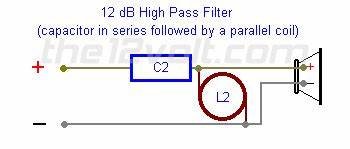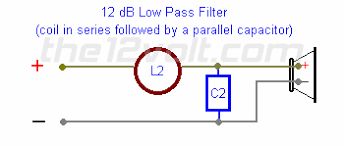Hi I need a bit of advice I've tested my speakers that have been in storage for 15yrs at very low volume & sounded OK before ordering my 4 channel Hifiberry Beocreate 4 amp with dsp & UMIK-1 for measuring all new to me need some advice on capacitors to protect the tweeters so I can play around with the software I pick things up quicker practically once I get the hang of things even hopefully upgrade drivers in cabinets I've uploaded Data Sheets of drivers after checking the part numbers I've had them from New thanks for any help
Attachments
The tweeter has a free air resonance of 1,400 Hz.
A 1st order crossover (capacitor alone on tweeter) would have to cross no lower than 5,600 Hz to protect the tweeter from low frequency overload.
Use a 2nd order crossover (capacitor and inductor) and you could cross over at frequency as low as 2,800 Hz.
Since the woofer only goes up to 4,000 Hz, the latter option would be the better one.
A 1st order crossover (capacitor alone on tweeter) would have to cross no lower than 5,600 Hz to protect the tweeter from low frequency overload.
Use a 2nd order crossover (capacitor and inductor) and you could cross over at frequency as low as 2,800 Hz.
Since the woofer only goes up to 4,000 Hz, the latter option would be the better one.
Since you seem new to crossovers, I attach diagrams showing what text book 2nd order high pass (tweeter) and low pass (woofer) filters look like.
The optimum crossover network to suit your drivers may contain additional components.
The optimum crossover network to suit your drivers may contain additional components.
Attachments
You can choose a value of capacitor and keep it connected through your measurements. This way it's effect is included in the measurement and will be compensated during your crossover development phase.
Some say to use a value that is lower than the tweeter resonance, but I'd only do that if you are planning to guess at your DSP settings rather than work them out properly with a crossover simulator.
Why not use a smaller value instead.. something that makes the capacitor part of the usable filter itself.
Some say to use a value that is lower than the tweeter resonance, but I'd only do that if you are planning to guess at your DSP settings rather than work them out properly with a crossover simulator.
Why not use a smaller value instead.. something that makes the capacitor part of the usable filter itself.
One thing I like to do is place the speakers upside down from how they were stored and leave them like that for at least a month while you play them.I've tested my speakers that have been in storage for 15yrs
Hi everyone I would like to include the capacitor in the usable filter what would you recommend
& what's the benefit of running the speakers upside down thanks
& what's the benefit of running the speakers upside down thanks
I would like to include the capacitor in the usable filter what would you recommend
If you are simply considering wiring a bipolar (non-polar or NP) capacitor in series with this 6 ohm tweeter then I recommend a value of 3.9 uF.
what's the benefit of running the speakers upside down thanks
What I think Cal means is that, for example, if the speaker drivers have been stored for a long time face down, then it may be wise to store them face up for a while before using them.
This is because gravity, particularly when acting on a heavy woofer cone over a long time, can displace the driver diaphragm from its natural resting position.
Turning the driver the opposite way round for a time will go toward cancelling out that unwanted displacement
Yeah, another good way in temperate climes is to set them outside on concrete, etc. and let the noonday day Sun do its 'thing'; just keep close tabs as it can be PDQ the further South you are as I learned the hard way with some damaged test drivers, rendering them not worth rebuilding.What I think Cal means is that, for example, if the speaker drivers have been stored for a long time face down, then it may be wise to store them face up for a while before using them.
Speakers stored vertically have their own sag. Over time the bottom of the cone will move outward while the top, inward. Simply viewing it from the side will tell how much. If you can’t see it, then perhaps it’s not important. I do the flip anyway, just to satisfy my compulsive side. If you want to get the full effect, turn the light out and use a flashlight shining at 90 degree from your eyes but on the same plane. Ie: you look from the side while shining the light from the top.
That’s certainly the best solution, provided the leads from the XO are long enough or you might have to extend them. Also, unusual but possible, that the tinsel leads sag themselves and make contact with the cone. Turning them over for a month while playing them just to help wiggle things back into shape a bit.
Just playing devil’s advocate here.
Just playing devil’s advocate here.

Been reading about all this for months & haven't come across this subject so far drivers I removed from one cabinet today are looking well when my capacitors are delivered I'll be running them with a generic crossover in dsp & run them upside down I'm hoping the damping fluid in tweeters is OK at low volume they sound well want to get a bit more volume through them to loosen them up before taking proper measurements thanks
Speakers stored vertically have their own sag.
Thanks Cal.
I thought that the drivers had been stored horizontally in their cardboard packaging boxes, while it appears they have been standing vertically in their wooden loudspeaker enclosures.
Still, both bases have been covered!
I'll go with the 3.9uf so I can start making my measurements with rew thanks
I would be happier if @AllenB should comment on the suitability of that value for that purpose.
Signal processing can compensate with + or - EQ, so any value of capacitor can be made to work. The value affects the headroom needed in the signal chain. A moderately sized capacitor allows a full range measurement sweep the same as the woofer.. changing the sweep parameters sometimes introduces doubt in the crossover region.. and it reduces concern about taking them loud enough to get a good S/N.
A smaller value capacitor may also reduce harmonic distortion. Although I don't usually find this to be a problem, it is often mentioned these days.
A smaller value capacitor may also reduce harmonic distortion. Although I don't usually find this to be a problem, it is often mentioned these days.
Last edited:
A moderately sized capacitor allows a full range measurement sweep the same as the woofer.
Would you regard 3.9 uF as a "moderately sized capacitor" in rsmex's case?
I just need to be assured I haven't given him a bum steer!
I have taken quite a few loud full range sweeps on dome tweeters with no problems.. I'm just cautious about recommending it.
If we want to be sure of what's happening we could simulate, and there are two things I'd expect to be of interest. The main one is the filter response since this represents the inverse of the needed headroom compared to the plain DSP version.
The other is the response with the capacitor but without EQ. Not that it's important but rsmex mentioned listening in a temporary state and it may help to know where it's at.
If we want to be sure of what's happening we could simulate, and there are two things I'd expect to be of interest. The main one is the filter response since this represents the inverse of the needed headroom compared to the plain DSP version.
The other is the response with the capacitor but without EQ. Not that it's important but rsmex mentioned listening in a temporary state and it may help to know where it's at.
- Home
- Loudspeakers
- Multi-Way
- Tweeter Protection

